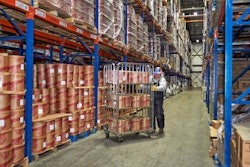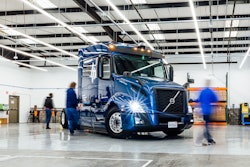
We’re all too familiar with today’s problems in distribution yards — yards require repetitive, manual tasks to be performed in often hazardous, inhospitable conditions. As one of the most under-invested-in links in the supply chain, distribution yards operate today much as they have for decades. Yet, yards play critical roles in getting more than 10 billion tons of freight annually from warehouses onto the open road. It’s time to re-think what’s possible for the role distribution yards play in the food and beverage supply chain.
The Coronavirus disease (COVID-19) global pandemic shined a light on a fragile supply chain and accentuated the inefficiency and safety concerns of distribution yards. As a result, industry leaders are turning with more urgency to digitization and automation to build a resilient supply chain and streamline operations.
Distribution yards are ideal for automation for three primary reasons: 1) operations involve manual, repetitive tasks, 2) yards require dull, dirty and dangerous work and 3) yards are located on private, well-defined property.
As yard automation solutions become more widely available, successful deployment of this technology depends on forward-thinking design and planning. Three key areas must be considered when planning for yard automation -- property, process and people. Yard automation quickly plugs into properties (land and facility) built and configured with its requirements in mind. Planning for automation also drives the evaluation of existing logistics processes. And, most importantly, people must be well-informed and trained to work alongside an autonomous system.
Property
The configuration on the property itself - both land and facility - determines how quickly and easily automation can be deployed in the distribution yard. First, work with your logistics real estate partner to secure fully-owned private properties. This allows you to test, iterate and optimize autonomous operations without the constraints of public road rules and regulation. For optimal performance of autonomous systems, identify land with a limited grade throughout the yard's footprint.
Once the site is selected, outline the layout specifications necessary for yard automation. This includes fully paved drive paths, standard parking to allow maximum trailer volume and designated space for electric vehicle charging stations. Avoid interfering with IT and communications infrastructure by ensuring adequate overhead clearance (i.e., no low clearance walking bridges or dock overhangs).
Drive-through loading dock design pays off
A yard truck driver typically spends about 2 minutes per trailer opening swing doors in the approach. This can add up to 240 minutes per day, or more than 15% of the total operating time of a single yard truck. By implementing a drive-through loading dock design, you eliminate the need for the yard truck driver to handle the trailer and you regain almost 15% of the yard truck's operating time all while providing a safer working environment for your personnel.
Next, turn your attention to the loading dock. To fully automate yards, the dock door design must allow for all over-the-road trailer doors to be opened inside the facility. This is particularly applicable for trailer fleets predominantly made up of swing doors. Today, swing doors require over-the-road and yard truck drivers to repeatedly exit their trucks to open and close the trailer doors before backing into or pulling away from a loading dock -- a manual, repetitive task that poses risks to personnel.
Using a drive-through loading dock design, the task of opening and closing swing doors relocates to inside the facility. A drive-through design features a vertical dock leveler, a vehicle restraint, a dock seal or shelter, dock lights and a safe sequence of operation. As you plan your facilities for swing door trailers, allow for the height and width of the dock door openings to be at least 10-feet wide and 10-feet high, ideally with 13- to 14-foot centers.
Yard automation requires a seamless link between warehouses and over-the-road trucks, which means moving tasks inside the warehouse and tightly connecting the swing door trailer, loading dock and warehouse.
Finally, plan for your property to have adequate electrical and IT infrastructure. Electrical specifications must support the distribution center's fast-charging needs of multiple electric yard trucks. Furthermore, the distribution yard and facility operating areas need to have adequate WiFi or LTE communications networking to facilitate autonomous operations. Additional IT infrastructure may also be required.
Process
Be sure to address existing processes and procedures to optimize for the safety and efficiency of autonomous yard operations. The repetitive, predictable traffic patterns found in today’s yards are ideal for autonomous systems. If you haven’t already, consider implementing automated check-in/check-out procedures for site access, limiting the number of pedestrians in the yard and minimizing vehicle traffic. Taking these additional steps now readies operations to support yard automation.
Autonomous yard operations alone provide great site-level benefits. But, when the yard automation ties to other software systems that manage the flow of freight in and out of the distribution center, the workflow of the entire distribution facility logistics coalesces. By taking an integrated software approach, distribution center operations, on the whole, can be exponentially optimized. Yard automation can integrate with homegrown or off-the-shelf, such as
- yard management systems (YMS),
- warehouse management systems (WMS)
- transportation management systems (TMS)
By taking an integrated system-wide approach, you’ll achieve end-to-end visibility of your freight. Over time, the business intelligence gathered and shared along the supply chain will lead to truly predictive freight logistics.
People
The successful deployment and adoption of yard automation calls for preparing existing personnel for new automation-related tasks, reorganizing integrated teams around automation and rallying personnel throughout the company around autonomy and its multifaceted benefits.
Like most successful initiatives, responsible deployment of yard automation hinges on executive sponsorship and strong leadership. Leaders must consider the change management processes and staffing plans that enable personnel to support autonomous yard operations or move into other high-value roles within the company. Another area to consider is how yard automation fits into corporate sustainability objectives, such as the transition from diesel to electric yard trucks.
Also at the corporate level, human resources and safety leaders need to prepare for managing the regular interaction between humans and robots. Project managers within the organization may need training in the area of automation so they can lead internal teams to launch autonomous operations, robotics and vehicle deployment successfully.
It’s equally important to include distribution facility and site-level leadership in the planning, deployment and ongoing management of yard automation. They will play critical roles in training the staff responsible for executing yard automation. Simple new training protocols related to yard automation include:
● Training yard dispatchers to utilize the software to task autonomous vehicles with work.
● Preparing existing maintenance staff to maintain site equipment like EV chargers and communications devices.
● Shifting the focus of some IT support resources to maintain internet connectivity throughout the yard and its components.
As yard automation scales across your logistics network, new roles may come to the forefront, such as operations management personnel to oversee the software and robotics across multiple sites.
Automation is expanding throughout the global supply chain. For CPG and grocery enterprises looking to innovate for long-term competitive gain, they must embrace autonomous yard operations. By nature, distribution yards already provide an ideal use case for autonomous operations. Yet, with some forward-thinking planning about properties, processes and people, you will be well-positioned to deploy yard automation quickly and start realizing more efficient, safer and sustainable operations.




















